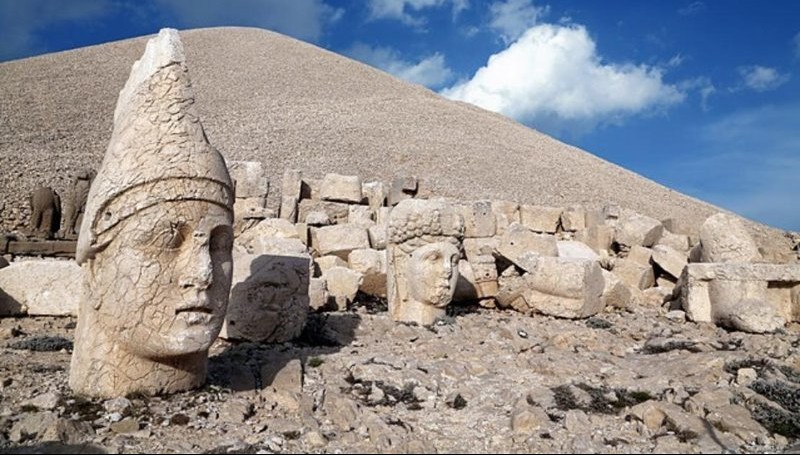Курган горы Немрут и царь Антиох
We come across to this interesting structure, equal to Pyramids, on the East of Taurus, Nemrut Mountain, located near the city of Adiyaman in Turkey. There is a tumulus built over 2000 years ago on the legendary Mount Nemrut, which is 2150 m above sea level.
This place was not known by the world until 1881. Only those who lived there knew and did not even step into it because they thought it was cursed. In 1881, the German Karl Sester explores this place and arrives after a two-month journey with Otto Puchstein from Germany. They soon understand that they have made an incredible invention. They learn from the Greek inscriptions that this is the tomb and the temple monument of Antiochus, King of Commagene.
For a while, Carl Humann works here, too. After a long break, in 1947, Theresa Goell, the first American female excavation head, started the excavations there again. She was an architect and the German Epigraph Dorner gave her the greatest support. The conditions of Mount Nemrut are very difficult. Even in the summer the weather is cold at night. There is no water source nearby and the closest settlement is far away. Under these conditions, they do excavations there for years. But what was more interesting was the ability to bring such a work to the body 2000 years ago. Currently, the studies are being carried out by the Turkish University named ODTU.
The Tumulus of Mount Nemrut was a perfect example of architecture and sculpture, combining Persian, Hellenistic and Anatolian traditions. It has a complex design and gigantic scales, is a unique project in the ancient world and has use of a unique high construction technique at that time. So it was included in the UNESCO World Heritage List in 1987.
Who is Antiochus, the King of Commagene? And why did he make such a work? Commagene kingdom, was a small family kingdom survived in the in Eastern Turkey for 230 years. In 163 BC, Ptolemeos, the governor, declared his independence. His son Callinicos Mithridates is raising the Kingdom. During the reign of his son, King Antiochus, the Kingdom of Commagene underwent its most powerful period.
This monument is built for himself as a tomb monument and as a worshiping center in 62 BC. Antiochus accepts himself as a descendant of both Macedonian Alexander and Persian King Darius. He presents himself as the king of both the East and the West. He also sees himself as god. 4 of the 5 figures in the tumulus are Gods and as a 5th person he takes part among them. At the foot of the tumulus, there are steles that is showing the gods are shaking hands with him.The tomb of Antiochus was not reached in the tumulus. In his will, he wanted to be gathered here twice a year. He wanted it to be a place of pilgrimage.
Mount Nemrut is built of limestone pebbles. Tumulus, which was 55 meters in height, is now 50 meters high. The tumulus itself and Nemrut Mountain are 2206 meters high. The diameter of the tumulus is 150 meters. There are terrace on the east and west. There is a 180 m long north terrace that connects the east and west terraces. There are many stele with a length of 80 meters.
On the east and west terrace there are five statues of gods, including the same sitting one. That is the message of the Tumulus and Antiochus, which are directed to both East and West. Hierothesion, which means sacred grave, was first used here. The appearance of the statues has both Greek and Persian characteristics, thus creating a synthesis. Already there are both Persian and Greek names of Gods and Goddesses.
On the two terraces, before there is an eagle and a lion, then there are 5 gods, again ending up with a lion and eagle as the protector. The heads of the gods are now on the ground and each is about 2 m in size and at least 2 tons. These god statues are estimated to be 8 meters together with their bodies.
The order is like this: Antiochus – Tyche – Zeus – Apollo – Herakles
In addition, on both terraces, there is a long script of 237 lines written in Greek behind the stone blocks forming the boards of the statues.
There is an altar on the eastern terrace. On the west terrace there is a Lion Horoscope. The stars on the lion symbolize 3 planets and 19 constellations. Jupiter, Mercury and Mars. In light of this, the completion date of the temple is 7 July 62 BC.
Commagene means a collection of genes. It was originally from the Sami race. King Antiochus first got along well with the Roman State so that the rich city Zeugma was donated to him. Later, Marcus was fighting with Antonius, and thanks to his master archers, Antonius did not lose to the Romans and he defended his castle. Antiochus built a mausoleum to his father in the ancient city of Arsemia. The Greek inscription in this mausoleum is the biggest inscription in Anatolia. The greatest aim of Antiochus was to unite the east and the west and all rights in his religion. King Antiochus died in 32 BC in a war with the Parthians. His son, II. Mithridates becomes the king. In 72 AD, the Romans ended the Kingdom of Commagene. Because this is made of tumulus pebbles, no excavation can be done, as this is damaging. So it is impossible to reach the grave of Antiochus.
While we invite you to see this wonderful works in the world, where the sun sets the most beautiful, we leave you with the words of the King-God Antiochus, waring those who want to harm this work: “Whoever, whether King or Emperor, harms the gods or this monument, let's face all kinds of catastrophe.”

